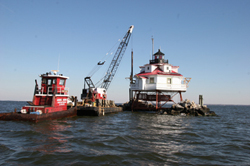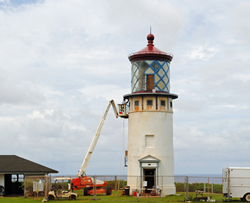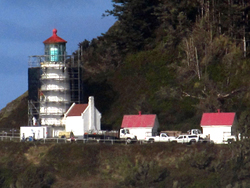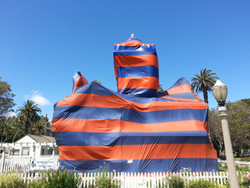 Program Description
Program Description
The U.S. Lighthouse Society offers a competitive grants program to help lighthouse preservation groups across the country save the iconic coastal landmarks that help define the nation’s rich maritime history and legacy.
The first nationwide preservation grants program of its kind, the society's Lighthouse Preservation Fund and Grants Program has been set up to support a variety of lighthouse projects and awards grants each year. As the Lighthouse Society’s preservation fund increases over time, so will the number of grants awarded.
More and more lighthouses have been turned over to not-for-profit groups, almost all of them based in coastal communities near specific lighthouses, as advances in navigation technology and the Coast Guard’s need to carefully target its resources render them too expensive to operate. While many do remain in government hands, many more are preservation projects typically funded through donations, group fund-raising and preservation grants from charitable foundations and local or state governments.
The U.S. Lighthouse Society makes the grants using interest from a fund generated by donations and fund investments. Many grants have been awarded to deserving lighthouse organizations since the launch of the grants program in 2015.
Those wishing to contribute to the society's Lighthouse Preservation Fund can do so at this link. Donations to the Fund are tax-deductible and will be applied to principal only so that your contribution will assist in generating grants to important lighthouse projects for years to come.
Guidelines
The U.S. Lighthouse Society’s Preservation Grants program is competitive. The application process, outlined in detail further down on this web page, has two major steps. The first step is for the applicant to submit a relatively short Letter of Interest (LOIs). In 2015, which was the first year of this grants program, the Society received 40 LOIs; 41 in its second year; and 31 in 2017, its third year. The Society’s Preservation Grants & Awards Committee then reviews the LOIs and selects about six applicants to proceed to the second step of the process which is submittal of a more comprehensive and full application. The Committee evaluates the final applications and selects three or four of them for awards. The Committee’s “budget allowance” is on the order of $20,000 to $25,000 of new awards each year. We have many initial applicants every year but only a limited amount of funds to award.
We ask that you read the following guidelines very carefully and abide by them so that you do not expend needless energy and time submitting an LOI that will not meet our criteria and so you can focus your energy and time on the types of projects that will have the highest chance of success in our evaluation process.
Who is eligible to apply to the grant program?
Any non-profit organization that either owns or is legally responsible for the preservation of a lighthouse, light station, lightship (hereafter referred to as “lighthouse”) or related entity that has an official 501(c)3 designation. Each eligible organization may submit only one grant application during each grant cycle. The legal owner of the lighthouse cannot be an individual person. The organization submitting the application does not have to be the owner; the owner can be a federal, state or local government agency that has given a lease or other legal authority to the applicant to preserve the lighthouse. The applicant must have its IRS 501(c)3 designation by the time it starts our application process.
For what purposes can the grant funds be used?
- Preservation planning (i.e., "non-capital" projects), for example: conducting site surveys with professional architects, engineers and preservationists to assess the condition of the lighthouse (or lightship) structures and developing preservation plans and identifying priorities for those structures; having professional architects, engineers and preservationists develop conceptual, preliminary or detailed designs of preservation work to be performed on the lighthouse structures; research at National Archives or other historic archives regarding the original design and construction of the lighthouse (or lightship) structures as well as later structural modifications, designs, drawings, assessments, surveys, etc., and;
- Preservation execution (i.e., "capital" or "bricks and mortar" projects), such as implementation of previous preservation planning activities (including the types of activities mentioned above) on the actual lighthouse (or lightship) structures.
What type of work is NOT covered by the grant program?
- Planning or execution/implementation of interpretation activities, for example: planning, design and construction of exhibits, displays or information panels which interpret historic operations (e.g., the use of Fresnel lenses, oil lamps and other artifacts) or the history of the keepers stationed there; research at the National Archives or other historic archives regarding lighthouse keepers or other aspects of life and operations at the station.
- Planning or execution of the preservation of structures on the lighthouse (or lightship) property that are not directly associated with the operation of the lighthouse/lightship and aids to navigation, e.g., walkways, stairs/steps and bridges that are traversed to get to the lighthouse (or lightship), or nearby viewing decks.
- Routine maintenance, which includes such activities as periodic scraping and painting and application of other coatings, periodic roof replacements, etc.
- Planning or execution of preservation work already underway or completed. Only preservation work yet to be conducted (after a grant award) will be considered.
How much grant funding can each applicant request?
Each application can request up to a maximum of $10,000. We expect to award at least 2 grants with each application cycle.
Are matching funds required?
No match is required from the applicant. However, the applicant's availability of matching grants or funds will be given additional credit in the application evaluation.
How much time will an award recipient have to execute the grant project?
The target maximum time limit for the grant applicants to execute their project is 12 months. However, extensions can be considered and granted on a case-by-case basis if the work is progressing well but not fully completed within the 12 months.
What type of projects stand a better chance of being selected?
- Projects for lighthouses, light stations or lightships that are on the National Register of Historic Places;
- Planning or execution projects that require near-term work to stop, prevent or repair deterioration or damage to vital elements; failure to conduct the work will lead to further deterioration and possible failure of vital elements;
- For example, a project whose scope is to stop water intrusion in a tower lantern room with an active aid to navigation and to repair damage caused by the water intrusion would be preferred over a project whose scope is to repoint interior brick areas in a light station oil house;
- Planning or execution projects that require near-term work to address issues that very adversely affect safety or health of light station personnel or visitors;
- Planning or execution projects where the specific element/feature on which the work is proposed to be done is itself historic;
- For example, work on a historic lantern on a historic tower would take priority over work on a modern replica lantern, even if it were on a historic tower;
- Planning or execution projects where discussions with the State Historic Preservation Office have already occurred, if required or if appropriate, and approval, if not already obtained, is anticipated in the near-term;
- Planning or execution projects where qualified professional contractors, if they are to be used, have already been sought, and valid quotes have been obtained;
- Planning or execution projects that have a total budget greater than the requested grant and have the additional funding in hand or it will be available in the near-term;
- Projects where the grant amount requested can make a significant impact, i.e., where the overall project is not “too big” or “too small”.
- For example, a grant request of $10,000 to address a non-specific element of a $1,000,000 project will not do as well in our evaluations as a grant request of $10,000 for a very specific element of a $50,000 project, especially if the applicant already has funds for at least part of the rest of the project.
Can grants funds be used for routine maintenance?
- No. Letters of Interest where the scope of work consists primarily of routine maintenance are not acceptable. Routine maintenance includes such things as periodic scraping and painting and application of other coatings, periodic roof replacements, etc.
2023 Preservation Grant Cycle
| October 27, 2023 | Grant cycle begins |
| November 21, 2023 | Letters of Interest (LOIs) due - last day for submittal |
| January 14, 2024 | Organizations that submitted an LOI will be notified if they were selected to proceed to application phase |
| February 4, 2024 | Last day to submit an application for the organizations selected in the LOI phase |
| February 26, 2024 | Grant awards announced |
Submitting a Letter of Interest
- We use Common Grant Application to manage our grantmaking process.
- If this is your first time using the Common Grant Application, please open an account by signing up here. Returning users can login here.
- After you login the first time, you will be given the option to go to the "Dashboard" page or to go directly to start a draft application.
- If you have any questions about using the Common Grant Application site, please contact the Common Grant Application directly. Their contact information can be found by going to www.commongrantapplication.com and clicking on the contact button. They may also be reached by phone at: +1 (310) 490-1277.
Letter of Interest Evaluation Criteria
- Does the applicant organization meet the criteria?

- Is it a current, legal 501(c)3 non-profit organization recognized by the IRS? Does it own or have the legal authority to conduct the proposed preservation work?
- Does the proposed scope of work meet the criteria?
- Is it exclusively for preservation planning or for preservation execution?
- Is the grant amount requested less than the maximum of $10,000?
- How vital/important does the project appear to be to the overall preservation program for the lighthouse, light station or lightship?
- How feasible does the project appear to be for the grant amount requested? Does it appear that it can be done within 12 months of grant award?
- How knowledgeable does the organization appear to be about what is required in a project of this nature? Does it have a known track record or reputation? Is it positive or negative?
Application Evaluation Criteria

Historic significance of lighthouse/lightship/light station
For example, is the lighthouse on the National Register (or determined to be eligible)?
Impact of grant project to lighthouse "health"
- For example, is this proposal for a project that requires immediate attention because of deteriorating conditions, or for activities that will help complete an ongoing project, or something that could be put off for a year or more?
Feasibility of project
- Is the scope/schedule/cost reasonable and realistic?
Soundness of technical approach
- Is the technical approach sound in terms of appropriate historic preservation (e.g., does it comply with the Secretary's Standards for the Treatment of Historic Structures, State Historic Preservation Office requirements, etc.) and in terms of use of qualified resources to execute the project, etc?
 Management experience/track record of applicant
Management experience/track record of applicant
- Does the applicant organization appear to have the requisite knowledge or experience to manage the project?
- Does it have a track record? Is it positive or negative?
- Does the selection of the key personnel indicate that the organization understands what skills are needed to execute the project?
- Does the applicant organization appear to have adequate financial health to preserve this lighthouse, light station or lightship?
Instructional Video
A recording of a live webinar is available to help you learn more about our Guidelines and the Application, Selection and Execution Process and to address your questions. Click Here to view the video.
Check out our Preservation Grants Brochure
If you have any questions, please contact:
U.S. Lighthouse Society
Phone: (415) 362-7255
Email: grantsprogram@uslhs.org
